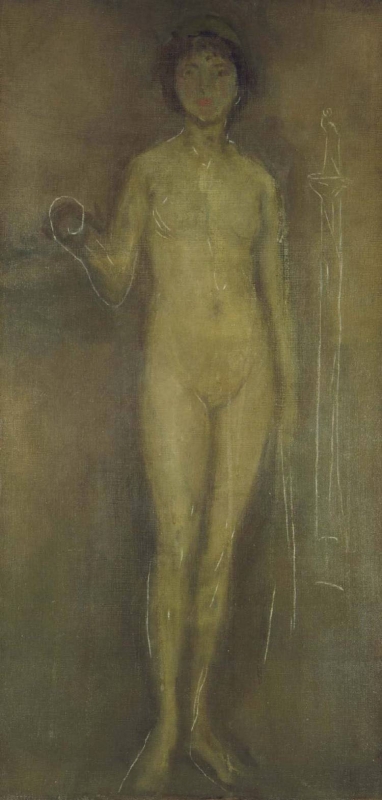Study of the Nude probably dates from between 1898 and 1899. 1 It is painted over a reclining nude figure, lying on a sofa, with the top of the canvas corresponding to the left side (the head is just visible to left of the standing nude's right arm). This figure could have dated from several years earlier.
Study of the nude may have been part of the series planned by Whistler to follow Purple and Gold: Phryne the Superb! - Builder of Temples [YMSM 490]. Whistler was working on a series of classical, mythological, biblical, historical and exotic subjects in 1898, as he told William Heinemann (1863-1920):
'I sit in the studio and could almost laugh at the extraordinary progress I am making and the lovely things I am inventing! - I have now in the studio a Phryne - a Dannae [sic] - an Eve - an Odalisque - and a Bathsheba ... I must not allow small ordinary considerations of Exhibition ... to interfere with work of this character which I always looked forward to and was sure would one of these days announce itself - bursting forth suddenly as the result of much preparation! All these inventions are since you left me the other day!' 2
The partial label of Bourlet & Sons, London frame-makers and exhibition agents, on the verso of this Study of the Nude, suggests it was framed in London.
It may have been one of 'two pictures ... in their new frames' that Whistler asked Rosalind Birnie Philip (1873-1958) to send through Goupil's, the London art dealers, to him in Paris in December 1899. His letter reads:
'[I]f Ronnie [Birnie Philip] think of coming over, you may as well put his picture in with the others for the Goupils to send - Also a nude figure begun from Lillie Pettigrew - a sort of Eve with an Apple in her hand ... Indeed while you are about it, there are two pictures similar in shape from the Lillie in their new frames - may as well both come.' 3
The model mentioned was Lilian Pettigrew (b. 1870) and 'a sort of Eve' is Eve [YMSM 491].
The letter is illustrated with pencil sketches of Two paintings of nudes [M.1601], which may have included this oil but are too small to identify the subjects with certainty. 4
Another possibility is that the study of the nude was used as a demonstration piece to show students at the Academie Carmen in Paris, where Whistler attended occasionally in 1899.
Last updated: 9th April 2021 by Margaret







